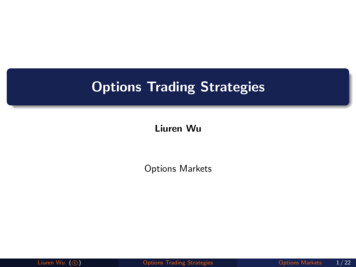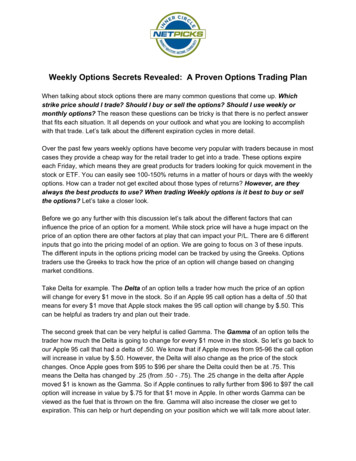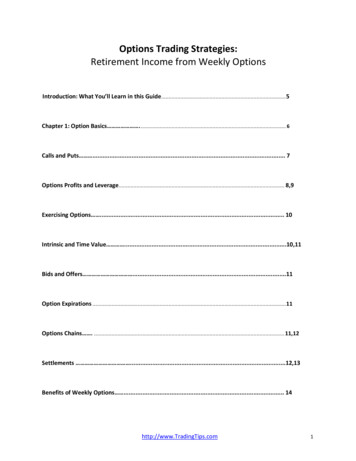
Transcription
Options Trading StrategiesLiuren WuOptions MarketsLiuren Wu ( c )Options Trading StrategiesOptions Markets1 / 22
ObjectivesA strategy is a set of options positions to achieve a particular risk/returnprofile.For simplicity, we focus on strategies that involve positions in only Europeanoptions on the same underlying and at the same expiration.The zero-coupon bond and the underlying forward of the same maturity arealways assumed available.We hope to achieve three objectives:1 Given a strategy (a list of derivative positions), we can figure out itsrisk profile, i.e., the payoff of the strategy at expiry under differentmarket conditions (different underlying security price levels).2Given a targeted risk profile at a certain maturity (i.e., a certain payoffstructure), we can design a strategy using bonds, forwards, and optionsto achieve this profile.3Be familiar with (the risk profile, the objective, and the compositionof) the most commonly used, simple option strategies, e.g., straddles,strangles, butterfly spreads, risk reversals, bull/bear spreads.Liuren Wu ( c )Options Trading StrategiesOptions Markets2 / 22
Put-call conversionsPlot the payoff function of the following combinations of calls/puts and forwardsat the same strike K and maturity T .1Long a call, short a forward.Compare the payoff to long a put.2Short a call, long a forward.Compare the payoff to short a put.3Long a put, long a forward.Compare the payoff to long a call.4Short a put, short a forward.Compare the payoff to short a call.5Long a call, short a put.Compare the payoff to long a forward.6Short a call, long a put.Compare the payoff to short a forward.Liuren Wu ( c )Options Trading StrategiesOptions Markets3 / 22
Put-call conversions: Payoff comparison (K 100)21515151010105550Payoff2000 5 5 5 10 10 10 15 15 2080859095100105Spot at expiry, ST110115 2080120 158590495100105Spot at expiry, ST110115 20801201515151010105550Payoff200 5 5 10 10 10 15 159095100105Spot at expiry, ST110115120 208095100105Spot at expiry, ST1101151201101151200 58590620 208085520PayoffPayoff320PayoffPayoff120 15859095100105Spot at expiry, ST110115120 2080859095100105Spot at expiry, STThe dash and dotted lines are payoffs for the two composition instruments.The solid lines are payoffs of the target.Liuren Wu ( c )Options Trading StrategiesOptions Markets4 / 22
The linkage between put, call, and forwardThe above conversions reveal the following parity condition in payoffs of put,call, and forward at the same strike and maturity:Payoff from a call Payoff from a forward Payoff from a putPayoff from a put Payoff from a forward Payoff from a callPayoff from a call Payoff from a put Payoff from a forwardIf the payoff is the same, the present value should be the same, too (put-callparity):ct pt e r (T t) (Ft,T K ).At a fixed strike (K ) and maturity T , we only need to know the two pricesof the following three: (ct , pt , Ft,T ).One of the three contracts is redundant.Liuren Wu ( c )Options Trading StrategiesOptions Markets5 / 22
Review: Create forward using spot and bondIn the absence of forward, use spot and bond:Can you use a spot and bond to replicate a forward payoff?What’s the payoff function of a zero bond?Liuren Wu ( c )Options Trading StrategiesOptions Markets6 / 22
Popular payoff I: Bull spread201510Payoff50 5 10 15 2080859095100105Spot at expiry, ST110115120Can you generate the above payoff structure (solid blue line)using (in addition to cash/bond):two callstwo putsa call, a put, and a stock/forwardWho wants this type of payoff structure?Liuren Wu ( c )Options Trading StrategiesOptions Markets7 / 22
Generating a bull spreadTwo calls: Long call at K1 90, short call at K2 110, short a bondwith 10 par.Two puts: Long a put at K1 90, short put at K2 110, long a bondwith 10 par.30202025151520101551005 10 5 15 10 20 15 25859095100105Spot at expiry, STLiuren Wu ( c )1101151205 50 208010PayoffPayoffPayoffA call, a put, and a stock/forward: Long a put at K1 90, short a call atK2 110, long a forward at K 100 (or long a stock, short a bond at 100 par).0 5 10 15 20 3080859095100105Spot at expiry, ST110115Options Trading Strategies120 2580859095100105Spot at expiry, ST110115120Options Markets8 / 22
A general procedure to replicate payoffsEach kinky point corresponds to a strike price of an option contract.Given put-call party, you can use either a call or a put at each strike point.Use bonds for parallel shifts, use forwards for overall slope change.A general procedure using calls:Starting from the left side of the payoff graph at ST 0 and progressto each kinky point sequentially to the right.If the payoff at ST 0 is x dollars, long a zero-coupon bond with anx-dollar par value. [Short if x is negative].If the slope of the payoff at ST 0 is s0 , long s0 shares of acall/forward with a zero strike — A call at zero strike is the same as aforward at zero strike. [Short if s0 is negative.]Go to the next kinky point K1 . If the next slope (to the right of K1 iss1 , long (s1 S0 ) shares of call at strike K1 . Short when the slopechange is negative.Go to the next kinky point K2 with a new slope s2 , and long (s2 s1 )shares of calls at strike K2 . Short when the slope change is negative.Keep going until there are no more slope changes.Liuren Wu ( c )Options Trading StrategiesOptions Markets9 / 22
A general procedure to replicate payoffsA general procedure using puts:Starting from the right side of the payoff graph at the highest strikeunder which there is a slope change. Let this strike be K1 .If the payoff at K1 is x dollars, long a zero-coupon bond with anx-dollar par value. [Short if x is negative].If the slope to the right of K1 is positive at s0 , long s0 of a forward atK1 . Short the forward if s0 is negative.If the slope to the left of K1 is s1 , short (s1 s0 ) shares of a put at K1 .Long if (s1 s0 ) is negative.Go to the next kinky point K2 . If the slope to the left of K2 is s2 , short(s2 s1 ) put with strike K2 .Keep going until there are no more slope changes.A general procedure using out-of-the-money optionsI’ll leave this for the ambitiousLiuren Wu ( c )Options Trading StrategiesOptions Markets10 / 22
Example: Bear spread201510Payoff50 5 10 15 2080859095100105Spot at expiry, ST110115120How many (at minimum) options do you need to replicate the bear spread?Do the exercise, get familiar with the replication.Who wants a bear spread?Liuren Wu ( c )Options Trading StrategiesOptions Markets11 / 22
Example: Straddle302520Payoff151050 5 1080859095100105Spot at expiry, ST110115120How many (at minimum) options do you need to replicate the straddle?Do the exercise, get familiar with the replication.Who wants long/short a straddle?Liuren Wu ( c )Options Trading StrategiesOptions Markets12 / 22
Example: Strangle4035Payoff302520151080859095100105Spot at expiry, ST110115120How many (at minimum) options do you need to replicate the strangle?Do the exercise, get familiar with the replication.Who wants long/short a strangle?Liuren Wu ( c )Options Trading StrategiesOptions Markets13 / 22
Example: Risk Reversal10108866442PayoffPayoff200 2 2 4 4 6 6 8 8 1080 1080859095100105Spot at expiry, ST110115120859095100105Spot at expiry, ST110115120How many (at minimum) options do you need to replicate the risk reversal?Do the exercise, get familiar with the replication.Who wants long/short a risk reversal?Liuren Wu ( c )Options Trading StrategiesOptions Markets14 / 22
Example: Butterfly spread30252015Payoff1050 5 10 15 2080859095100105Spot at expiry, ST110115120How many (at minimum) options do you need to replicate the butterflyspread?Do the exercise, get familiar with the replication.Who wants long/short a butterfly spread?Liuren Wu ( c )Options Trading StrategiesOptions Markets15 / 22
From butterflies to histograms/probabilitiesSuppose you construct a butterfly with the center strike at 100, and withthe two side strikes at 99 and 101. Then, you will get paid 1 when thestock price reaches 100 at expiry, and paid nothing if the stock price iseither below 99 or above 101.The price of the butterfly reflects the “risk-adjusted” probability thatthe stock price will fall between (99,101), times the present value ofone dollar (discount).You can construct such butterflies with center strikes at 80, 81,· · · , 119, 120, .The cost/price of each fly reflects the probability of the stock price fallingaround the center strike of that fly.Thus, if you have options at all strikes, you can construct these butterfliesand infer the probabilities of the future stock price reaching each price level.Breeden and Litzenberger (1978) for the underlying theory, and manyfollowing papers on practical implementation and applications .Liuren Wu ( c )Options Trading StrategiesOptions Markets16 / 22
From call/put spreads to up/under oddsSuppose you construct a call spread by long a call at K 100 and short acall at K K 101. What is your payoff?Let the strike distance K shrink, and take 1/ K shares of thespread, you obtain a synthetic binary option that pays off iff thesecurity price is greater than K .The price of this spread represents market risk-adjusted expectation ofthe security price going above K .Example: What’s the probability that TSLA price will be above 400 onemonth from now? What odds are you willing to offer on TSLA?You can also construct probability of going below K via a put spread: Longa put at K 100 and short a put at K K 99Liuren Wu ( c )Options Trading StrategiesOptions Markets17 / 22
Replicate smooth terminal payoff functionIf the payoff function f (ST ) does not have “kinks” but is a smooth(differentiable) function:f (ST ) f (Ft )bonds f(0 (Ft )(ST Ft )forwards)R Ft 00 f(K)(K S)dKTOTM options R0 00f (K )(ST K ) dKFtWith bonds, forwards, and European options, we can replicate any terminalpayoff structures, smooth or kinky.The above formula is analogous to our “general approach” earlier on kinkypayoffs, using out-of-money forward options.Reference: Carr and Madan, Optimal positioning in derivative securities,Quantitative Finance, 2001, 1, 19–37.Liuren Wu ( c )Options Trading StrategiesOptions Markets18 / 22
Smooth out the kinks: Can you replicate pot at expiry, ST110115120How many options do you need to replicate this quadratic payoff?You need a continuum of options to replicate this payoff.The weight on each strike K is 2dK .Who wants long/short this payoff?The variance of the stock price is E[(ST Ft,T )2 ].We usually talk about variance not on price changes but on returns.Replicating return variance is harder, but doable .Variance swap contracts on major stock indexes are actively traded.Reference: Carr and Wu, Variance risk premiums, Review of FinancialStudies, 2009, 22(3), 1131–1141.Liuren Wu ( c )Options Trading StrategiesOptions Markets19 / 22
VIX— CBOE’s Volatility IndexIt is meant to capture the expected annualized volatility of the S&P 500Index return over the next 30 days.It is created as the weighted average price of 30-day S&P 500 Index optionsacross all strikes, with the weighting proportional to 1/K 2 .For history and technical details: Carr and Wu, A tale of two indices,Journal of Derivatives, 2006, 13(3), 13-29.Liuren Wu ( c )Options Trading StrategiesOptions Markets20 / 22
DOOM puts as credit insuranceAssume: A company’s stock price will stay about 5 as long as the companyis solvent, but will drop to zero upon bankruptcy.Is this assumption reasonable? Make adjustments to make yourselfcomfortable.Under this assumption, we can create a pure credit insurance contract fromdeep-out-of-money (DOOM) American puts on the company’s stock:Select any DOOM put option with strike (K ) below 5, and take aposition of 1/K on this put (P).Or select two DOOM put options with strikes below 5: 5 K2 K1 ,and take a spread position 1/(K2 K1 ) of P2 P1 .Payoff: receive 1 if and only if the company defaults before the optionexpires.Default probability: 1/P or (P2 P2 )/(K2 K1 ) represents a marketestimate of the default probability of this company before expiry.Reference: Carr and Wu, A simple robust link between American puts andcredit protection, Review of Financial Studies, 2011, 24(2), 473–505.Application: CBOE’s DOOM index.Liuren Wu ( c )Options Trading StrategiesOptions Markets21 / 22
SummaryIdentify what risk you want to bet on and what risk you want to hedge.Replicate your desired payoff structure using vanilla options and forwards.Requirements:Given a payoff structure, you can design one replication strategy withoptions, forwards, and bonds.Given a portfolio of options, forwards, and bonds, you can plot thepayoff structure of the portfolio.Given a specific scenario (e.g., ST 110), you can compute theterminal payoff value of a pre-specified portfolio.Liuren Wu ( c )Options Trading StrategiesOptions Markets22 / 22
Each kinky point corresponds to a strike price of an option contract. Given put-call party, you can use either a call or a put at each strike point. Use bonds for parallel shifts, use forwards for overall slope change. A general procedure using calls: Starting from the left side of the payo graph at S T 0 and progress to each kinky point sequentially to the right. If the payo at S T 0 is x .











